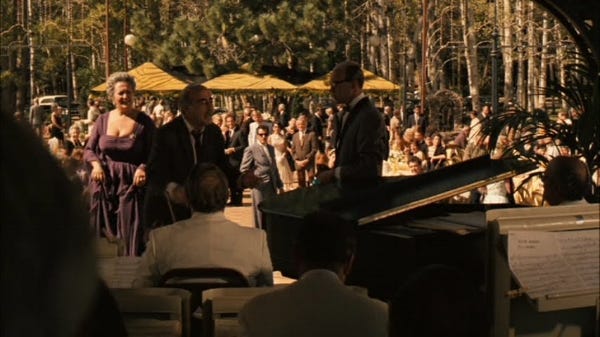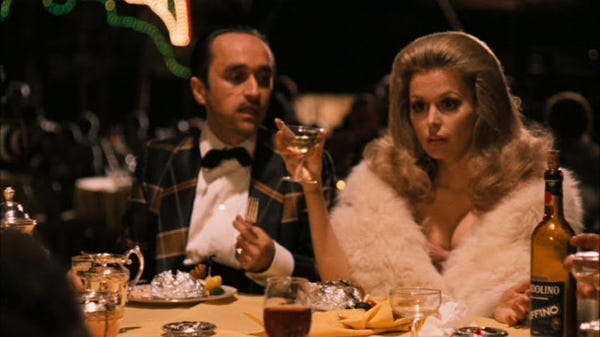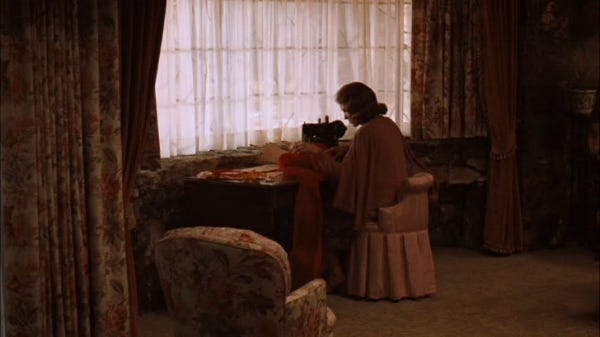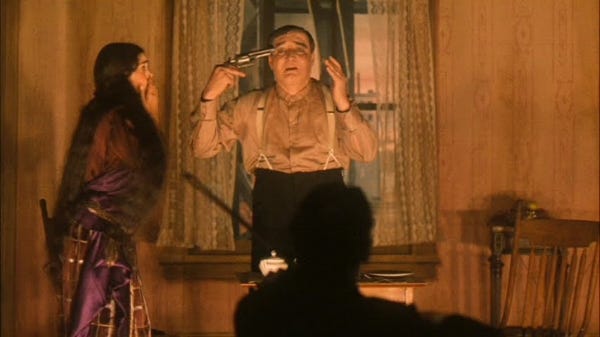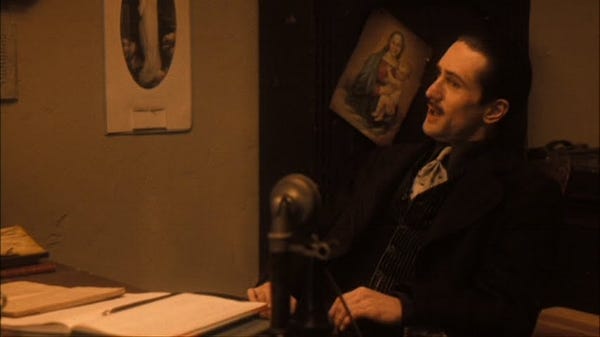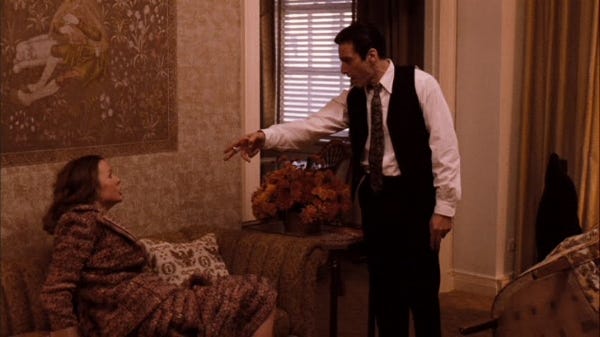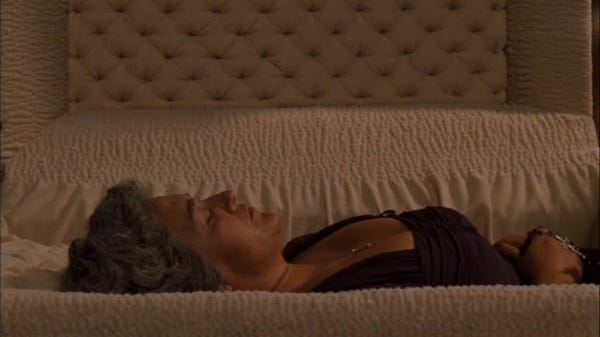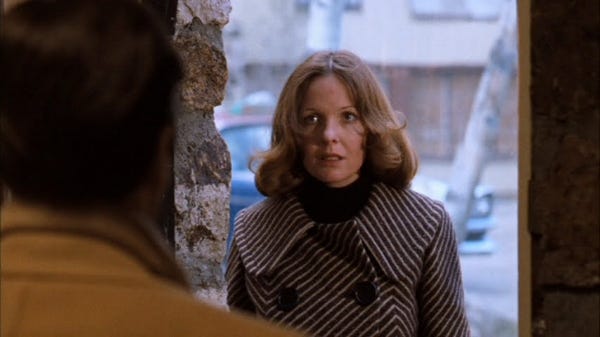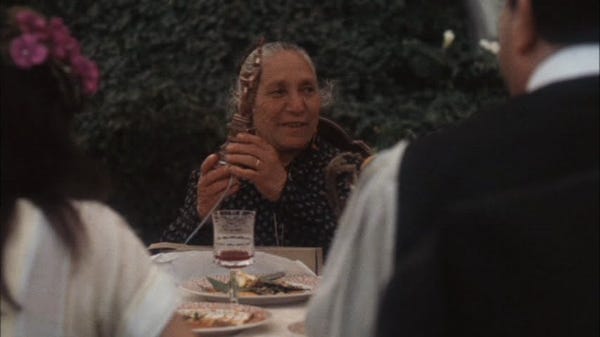The Godfather Part II: Coppola's Mothers
The Godfather Part II begins with an empty chair. Though in control, his ring kissed by a henchman, Michael Corleone has still not assumed his father’s place . Coppola transitions from the godfather’s chair to the old Sicilian countryside, nearly 60 years before. Insects chirp as a funeral procession approaches. Some expositional information – taken from Puzo’s novel – is written out for us. The legendary “godfather” is not “Vito Corleone,” but was born in 1892 as “Vito Andolini” in the town of Corleone, Sicily. In 1901, his father Antonio Andolini was murdered for an insult to the local mafia chieftain, Don Ciccio, and so too was his vengeful older brother, Paolo.
Vito, pale and thin, is introduced at his mother’s side. His silences and penetrating glances augur the icy intelligence possessed by the lofty figure we know he’ll become. The procession is broken up by the crack of gunfire, creating a frenzied skirmish. A woman in the distance yells, “They killed your son! They killed Paolo!” Coppola cuts to a body on the rocks and a head of thick hair soiled with blood. The widow, her younger son behind her, weeps over the body. “My son, my son,” she cries, cradling the corpse.
The Godfather Part II’s first moments address the relationship of parent to child, and siblings to each other (it also portends the end of the third film, as Michael cries over his slain daughter). Vito holds fast to his grieving mother, and he continues to look on as she holds his brother’s corpse. The sanctity of fraternal blood ties, overlooked by a maternal one, is the film’s dianoia. Vito sympathetically absorbing his mother over her dead son instills a sense of the importance—and fragility— of the “Family” construct and how it must be protected. The story of Michael follows another son’s tortured relationship with his older brothers: the biological “passed-over” misfit brother Fredo and adopted brother Tom Hagen. Texturing this is a subplot involving capo (Clemenza surrogate) Frank Pentangeli’s (Michael V. Gazzo) relationship with his estranged brother, the latter living in Sicily and whose sudden arrival haunts the Americanized Frankie, who has cut a deal with the government and plans on violating his mafia oath.
The prologue also introduces the motif of practical necessity. Juxtaposed against the Andolini family sentiments are the practical methods of Don Ciccio, responsible for murdering the Andolini men. The widow Andolini goes to Ciccio’s villa, pleading for the life of young Vito, whom the don must also kill. She points out that Vito is “slow and dumb-witted and wouldn’t hurt anyone.” But reason dictates that when he becomes a man, he will seek revenge. Ciccio understands it’s necessary to levee the waves of contingency. Ciccio’s desire to kill nine-year-old Vito is not born out of malice towards the boy or his mother, or even the original Antonio Andolini “insult”: it returns to the quandary of “personal” vs. “business.” Ciccio wants to pre-emptively solve a problem before it has time to bud and become another vendetta.
A woman’s plea to a mafia chieftain for mercy will be repeated in the film, at least twice to the adult Vito, and then quite significantly to Michael near the end. Compare Ciccio to how Don Vito handles the request of the widow Signora Colombo, and then how Michael handles the request of his sister Connie, who begs him to forgive Fredo. The tragic irony is that Michael becomes Don Ciccio’s double, the man who would murder his father.
Desperate, the widow holds a knife to Ciccio’s throat, instructs Vito to run, and is killed by the don’s bodyguards. She gives her life for her son. His primary instinct was not to flee, but to come forward to her aid. He relies on the kindness of loyal family friends to find a way out of Corleone. The film dissolves from the town center to Ellis Island. Vito Andolini Corleone, we see, is a variation of the archetypal savior orphan, saved in a basket and in the mold of characters ranging from Moses to Luke Skywalker.
While The Godfather Part II’s premise is framed with a father compared with his son, it is significantly replete with allusions to motherhood. For both Vito and Michael, the phantasmagoric Father is a mysterious ghost hanging over their destiny, but the Mother is a lively representation of Old World attachments. Vito’s severance from his mother makes him a boy without a family (or country). Renamed by customs officials, he’s quarantined for smallpox, the number 7 on his chest, the number 52 on his government bed. She’s the omphalic naval root tying these men to their familial obligations. It’s only when his mother Carmella Corleone dies that Michael goes through with fratricide. Fredo is killed while reciting a Hail Mary, the Catholic prayer paying tribute to the Mother of God whose “fruit of thy womb” was the world savior. The mother’s death incepted the Corleone saga, and the mother’s death likewise signals its decline.
*
The opening of Vito’s grieving mother, holding the corpse of one son and begging for the life of another, defines what Coppola is trying to say about the expansion from the Old to the New World, as Vito goes westward, silently preserving the memory of what he lost. Ellis Island in 1901 dissolves into Lake Tahoe, 1958, as Vito’s grandson, Anthony, is receiving first communion, the ritual inaugurating a young person into a holy family. The film soon cuts from this ritual to interfamily dynamics, and we should compare the solitary devotion and struggle of the prologue’s Andolini widow to the Americanized treatment of Carmella Corleone and her daughter Connie.
The first lines uttered in the 1958 storyline (other than Father Carmello’s First Communion prayers) are Connie’s “Mama! Mama!” as she swerves through the glitzy lakeside party to her mother’s table, holding the hand of her WASPy fiancé, Merle Johnson (Troy Donahue). Superficial Connie, garish and loud (and certainly processing years of trauma as a widow herself), proclaims that she has a “gift for my mama,” handing her an expensive piece of jewelry. Meanwhile, Merle kisses Carmella on the cheek, annoying her. During the wedding of Part I, Carmella was a lively force, singing Sicilian folk songs and dancing. But during this Lake Tahoe gathering, she looks lethargic. Her role is reduced to customary kisses and presents. Ties to the Old Country are fading, commensurate with her maternal function.
Her sole contemporary here is Frank Pentangeli, an Old Country caporegime who presides over the former Corleone compound in New York (in Coppola and Puzo’s original screenplay, Pentangeli was Peter Clemenza; Peter became Frankie after Coppola was unable to make a deal with actor Richard Castellano). He complains about servers offering canapés that are really “chopped liver and a Ritz cracker.” He tries to get the WASPy band to play a tarantella. Carmella stands behind Pentangeli while he irately protests, “Out of thirty professional musicians, there isn’t one Italian!” He tries to get an Italian melody started, but only gets “Pop Goes the Weasel.” The moment is funny, but in the full context of The Godfather Part II’s themes it’s deeply melancholy. The world of Frank Pentangeli and Carmella Corleone, so idiosyncratic during the wedding of Part I with the right wine (as opposed to “champagne cocktails”), sandwiches, and music, is obsolescent.
Maternally antipodal to Carmella is her daughter Connie, who’s appearing at the party solely to get some financial assistance from Michael. One week late in arriving to see her family, she is scolded by her mother for neglect of her maternal duties. “You go see your children first, and then you worry about waiting on line to see your brother!” When Connie gets in to see Michael, she tells him that she and Merle are getting married. “The ink on your divorce isn’t dry yet and you’re getting married?” Michael begins. “You see your children on weekends. Your oldest boy Victor was picked up in Reno for some petty theft you don’t even know about! You fly around the world with men who don’t care for you and use you like a whore!” “You’re not my father!” she retaliates. So why does he come to her? Because she needs money. Michael is the head of the family, but the “godfather” role that once generated awe is now a bank for withdrawals. Connie’s supplication to Michael is much more disrespectful than Bonasera to Vito in the first film.
A third noteworthy female character in Tahoe is Fredo’s wife, Deanna (Marianna Hill), a trophy showgirl spouse unable to fulfill any traditional familial role. At the dinner table, her hand crosses over to meet Merle Johnson’s, causing Carmella to frown and say something in Italian (in turn making the adopted Tom Hagen, a non-Sicilian who is acting more Sicilian than many of the Corleones, to chuckle). As Deanna drunkenly dances, feckless Fredo struggles to control her. “You’re just jealous because he’s a real man!” Deanna cries, emasculating Fredo in comparison to her dance partner. Fredo fumes, “Deanna, I swear I’m gonna belt you in the teeth!” “You couldn’t belt your mama!” She storms off, continuing to cause havoc: “Never marry a wop! They treat their wives like shit!” She realizes the faux pas. “I didn’t mean to say ‘wop’!” Of course, we should hope Fredo wouldn’t belt his mama. But what this moment suggests is that the fortunate few living this good American life have little sense of anything sacramental in family relationships, which Coppola projects onto motherhood. The Old World Adoration of the Holy Mother has fallen by the wayside for banal razzle dazzle.
The Godfather Part II, with these somewhat problematic and conservative sexual politics, is also a film about revolutions: personal, political, and sexual. The last woman we must consider in the Tahoe chapter is Kay Adams Corleone, Michael’s wife, pregnant for the third time. In Kay, the Mother is not an individual with functional agency but a prisoner to her feminine role. Hoping that their new child is a boy (perhaps so his progeny replicates his father’s line of sons), Kay is a functional vessel for the Corleone legacy more than she is an individual. As “times are changing,” a refrain of the trilogy, the silence that we see between Vito and Carmella is unacceptable for Kay in relation to Michael. Vito takes a bag of guns into another room, and his expression to his wife makes it clear that this isn’t her affair, and she’s fine with it. 40 years later, Michael does not tell Kay where he goes after an attempt on his life, expecting her to obediently stay within the Lake Tahoe compound. Michael has removed himself from the paternal role (gifts to the children are handled by Hagen), so how is Kay supposed to go about her maternal one? “I’m a prisoner in my own house, is that it?” she says to Hagen. “That’s not the way we look at it, Kay,” as if the Corleones (“we”) were a corporation. The opening scenes of The Godfather Part II show how protective, assured, and important a woman can be, and Michael takes that for granted as he invests his dreams in nothing but male heirs.
The immigrant struggle is theatrically rendered in 1917 for Vito and his friend Genco Abbandando while they watch a musical play, Senza Mama (written by Coppola’s maternal grandfather, Francesco Pennino). The stage doubles for the prologue’s Ellis Island, the orchestra pit’s violinist even mirroring the violinist during one of the Ellis Island tracking shots. Senza Mama is about a man who left his mother, leaving Naples for America with a “no good tramp.” He’s despondent and alone in America, thinking of his mother from whom he’s received no news. New York’s ghetto is not a land of opportunity, but a sad reminder of the world left behind, which only reaches out to them with news of death. The mother’s death in Senza Mama, as the westward journeyer follows a “no good tramp,” is a metaphor for the America of The Godfather Part II. Michael has led the Corleone family down a hole of prosperity that’s severed itself from the womb, the sacred sense of maternity—so important to Italian culture— degraded.
An important episode involves another widow, Signora Colombo. Her son’s beloved dog has caused her eviction, and she begs Don Vito to convince her landlord to let her stay. Since the death of her husband, her home is her umbilicus to any sense of value. He thinks about it and agrees to have a chat with the landlord, Signor Roberto. The pleas of Signora Colombo are crucial in the comparative exegesis of Vito and Michael. The rational thing would be for the young don to offer her money to move. But the weeping widow in black is a reflection of what he witnessed in his mother’s last moments. Signora Colombo brings Vito back to his omphalos. As he listens to her, we see a pointed symbol in Dean Tavoularis’ production design: a picture of the Virgin Mary.
Signor Roberto is oblivious to who “Don Vito” is, and so cannot be swayed by Vito’s request to let the widow stay. Vito gives him an increased payment advance to keep the Signora’s apartment, but the landlord sticks to the eviction after hearing Vito’s insistence that “the dog stays.” The fact that Roberto and Vito are paisan doesn’t matter; what matters is that the new tenants pay more and Roberto can rent out more apartments with the dog gone. This leads to the film’s most playful scene, as Roberto returns to Vito’s office (we notice Genco is now the loyal consigliere and the Corleone business is named after the grocery business of Genco’s father, with its ostensible interest in Sicilian olive oil imports). Roberto has made inquiries about Vito Corleone, and he is now foppishly obsequious. “Of course Signora Colombo can stay! Money isn’t everything! The rent stays like before!” Vito gently smiles and looks to Genco. Roberto revises himself. “I’ll even lower it! $5!” Vito again looks at Genco. “$10!” This pleases Vito and Roberto politely leaves, excessively thanking Vito. Again, the Virgin Mary icon is behind Vito, and Roberto begins his penitent visit by invoking “Holy Mary!”
The theme of maternal demise plays out in the final act. After Michael seals his victory by evading incarceration for perjury, Kay discloses a truth to him. Michael believed that Kay had a miscarriage, and that she blamed it on his absence and neglect. “I can change,” he says. “Oh Michael, you are blind,” she replies, laying out her confession. “It was an abortion. Something unholy and evil, just like our marriage is an abortion.” The things “going on between men and women for thousands of years” are subverted by Kay’s revolution as a galvanized woman, standing up to the tyranny of her husband just as the Widow Andolini stood up to Don Ciccio (however contradictory the outcome is for the offspring).
Kay understands that the symbolism has ossified in Michael Corleone’s family, and instead of bringing any more of Michael’s sons into the world – who would continue this unnatural “Sicilian thing” – she willfully cuts the cord. After this scene Coppola moves to the final flashback, showing Vito’s journey back to Sicily to carry out his revenge on the elderly Ciccio. It’s a very significant transition, not only dramatically but formally as, unlike all of the other flashback introductions, it is a straight cut instead of a slow dissolve, denoting the absolute separation between present to past, or children to parents. Time itself is aborted. Kay becomes the anti-Virgin Mary, but her transgression is a necessary symbolic action that tells the truth to Michael.
The sanguine imagery is grotesquely realized elsewhere, as with the dead prostitute at a Corleone brothel, murdered by Al Neri to frame Senator Geary (G.D. Spradlin). Without a family, Tom Hagen tells the Senator, it's as though the hooker never existed. Though family denotes "reality" ("A man who doesn't spend time with his family can never be a real man," Don Corleone says in Part I), the customary murder of an innocent employee is symptomatic of the Corleones’ decay. The dead hooker is another metaphor, the blood on the sheets seeming to point to the birth canal between her legs (making the image more unsettling). The Mother is absent, little more than a relic adorning the empty Catholic rituals. The fruit is cut off from the root, like the films’ ominous oranges.
And then Michael’s mother dies. After this, Michael will order the death of Fredo, along with all other family enemies. The film has come full circle and Michael is much like Don Ciccio, the reasonable mafia chief who killed Michael’s grandparents and tied up all loose ends. As he fishes with Al Neri in a boat, we hear Fredo’s final utterance, the Hail Mary prayer. Once his custom for good luck, the prayer is now meaningless.
The circle of motherhood closes when once more, like at the conclusion of The Godfather, the door is closed on Kay. Her separation from Michael imminent, Kay asks Anthony to come and kiss her once more before she leaves, the looming darkness of the increasingly onanistic father (unlike the other Corleones, Michael has no mistress), approaching. Anthony moves aside as Michael approaches the door. Michael looks upon the mother of his children and closes the door on her, her weeping muted, an inflection of what we've heard earlier through Vito's mother and Signora Colombo. Michael frames the negative image of Mother Love that we saw at the beginning of the film, as mother and son were hand-in-hand bound together through life and death. The adopted mother here, presented as a souvenir gift to Michael's maternal grandmother back in 1920s Sicily, is the statue of liberty, an alternative maternal icon that likewise has been perverted by how her sons have invested their inheritance. The family is aloft and detached, like Fredo's corpse in the boat.







